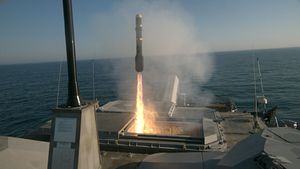The Freedom-class Littoral Combat Ship (LCS) USS Milwaukee (LCS 5) conducted a live-fire missile exercise off the coast of Virginia on May 11, the U.S. Navy said in a statement.
“The Milwaukee fired four longbow hellfire missiles that successfully struck fast inshore attack craft targets,” the service said. “During the evolution, the ship’s crew executed a scenario simulating a complex warfighting environment, utilized radar and other systems to track small surface targets, simulated engagements, and then fired missiles against the surface targets.”
This marks the first integrated firing of the so-called Surface-to-Surface Missile Module (SSMM), a 24-shot vertical launch system designed to engage smaller surface targets in close proximity to the LCS (e.g., swarms of speedboats) with AGM-114L Longbow Hellfire missiles vertically launched in rapid succession.
The operational range of the SSMM hellfire missiles is approximately 5 miles.
This was the second at-sea launch of hellfire missiles. In March 2017, the Freedom-class LCS USS Detroit conducted a successful structural test firing with hellfire missiles as part of the developmental test program for the LCS Surface Warfare Mission Package. The structural test firing aimed to test the capability of the LCS structure and equipment to withstand the vibration, shock, noise, gases, and other blast byproducts from the firing of a missile.
Using an open architecture design, both LCS classes — the mono-hull Freedom and trimaran-hull Independence variants — are modular, reconfigurable warships that can be fitted with interchangeable mission packages providing specific capabilities for surface warfare (SUW), anti-submarine warfare (ASW), and mine countermeasures (MCM) missions in the littoral region.
Initial operational capability (IOC) and deployment of the SSMM is expected in 2019.
“Delays in the development of the SSMM led to the initial deployment of a more limited surface warfare mission package aboard the LCS exchanging hellfire missiles for rigid hull inflatable boats and boarding teams,” I wrote last year. “The package also encompasses two 30- millimeter machine guns, two MQ-8B Fire Scout unmanned aerial vehicles and an MH-60S Seahawk helicopter.”
Despite IOC of the SSMM in 2019, the LCS will not be able to engage in high-intensity naval combat as a January 2018 report by the Pentagon’s office of Operational Test and Evaluation notes:
Survivability testing and preliminary analyses on both LCS variants continue to demonstrate that neither LCS variant is survivable in high intensity combat. Although the ships incorporate capabilities to reduce their susceptibility to attack, testing of analogous capabilities in other ship classes demonstrated that such capabilities have limited effectiveness in high intensity combat.
As I reported previously, the USS Milwaukee experienced a loss of propulsion in December 2015:
[…] the Freedom-class USS Milwaukee sustained a combining gear casualty about 64 kilometers (40 miles) off the Virginia coast during an Atlantic transit. The problem was traced back to a software issue, which caused a clutch not to disengage when the ship was switching engines, and not human error. Lockheed Martin fixed the issue by installing new software patches. The ship returned to active duty in June.
The U.S. Navy accepted delivery of its latest Independence-class LCS, the future USS Tulsa, last month.

































